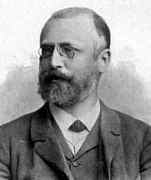Person: Weyr (2), Eduard

Eduard Weyr was a Czech mathematician who was the discoverer of a certain canonical form for square matrices.
Mathematical Profile (Excerpt):
- Eduard attended the Trinity elementary school from 1858 to 1861, then spent the year 1861-62 at the elementary school of Our Lady of the Snows.
- However, Eduard caught scarlet fever and missed most of his sixth year at school.
- Solin taught the course on the 'Geometry of Position' and the course on 'Graphical Statics' which Weyr attended.
- Studnicka gave a course on 'Analytical Mechanics' which Weyr attended.
- By the age of sixteen Weyr had already sent two mathematics papers to the Austrian Academy of Sciences in Vienna and, while he was a student, he published further mathematics papers in the Sitzungsberichte of the Vienna Academy, in Crelle's Journal, and in the Zeitschrift für Mathematik und Physik.
- The first volume of the Journal for the Cultivation of Mathematics and Physics of the Union of Czech Mathematicians and Physicists, published in 1872, contained a paper by Weyr on projective planes.
- The exceptional talents which Weyr showed in Prague led to him being awarded a state scholarship to continue to further advanced studies and, in October 1872, he went to the University of Göttingen where he attended lectures by several mathematicians.
- The most important lecture course he attended was the Theory of Abelian Functions and the General Theory of Algebraic Equations by Alfred Clebsch but this was cut short in November 1872, only weeks after Weyr arrived, when Clebsch died suddenly of diphtheria.
- Weyr attended Clebsch's funeral where he met Felix Klein for the first time.
- Klein invited Weyr to Erlangen but he decided to remain at the University of Göttingen where obtained his doctorate on 28 May 1873 for his thesis Über Algebraische Raumcurven.
- During the spring of 1875, Weyr also served as an assistant to professor Karl Josef Küpper (1828-1900), the professor of descriptive geometry at the Technical University of Prague.
- In the autumn of 1874 Weyr had been offered an extraordinary professorship at the newly founded University of Zagreb.
- With this appointment, Weyr now had a well established academic career with a good salary.
- Another role that Emil Weyr held was that of Permanent Secretary to the Union of Czech Mathematicians and Physicists.
- Josef Solin had been appointed as a full professor at the Prague Polytechnic in 1876 but he handed his teaching duties over to Weyr in 1878 when he took on other positions in the Polytechnic including rector and dean.
- Also in 1878 the third volume of Emil and Eduard Weyr's projective geometry book was published.
- We should note that Emil had been the major contributor to the first two volumes but Eduard was the major contributor to the third volume.
- Weyr was offered a full professorship at the University of Innsbruck in 1876 and, later in the same year, he was offered a full professorship at the University of Czernowitz.
- Weyr became a full professor at the Czech Polytechnic on 15 February 1881.
- Both Emil Weyr and Eduard Weyr were invited to lecture at the Congress.
- Eduard and Theresa Weyr's marriage was also in the Church of St Ludmila in the Vinohrady district of Prague.
- Eduard Weyr wrote geometrical papers and books mainly in projective geometry and differential geometry.
- One of his most important results in algebra concerns bilateral equations, where Weyr generalised results of James Joseph Sylvester on the solution of unilateral equations.
- In 1885 he discovered the Weyr matrix canonical form which outperforms the Jordan normal form in a number of mathematical situations.
- Most have never even heard of the Weyr form, a matrix canonical form discovered by the Czech mathematician Eduard Weyr in 1885.
- In the 2007 edition of the 'Handbook of Linear Algebra', a 1,400-page, authoritative reference on linear algebra matters, there is not a single mention of the Weyr form (or its associated Weyr characteristic).
- It is interesting that Weyr cites the work of Frobenius, Sylvester, Cauchy, and Hermite in canonical forms but never mentions Jordan in this context! However, in his work on the history of mathematics, Brechenmacher notes that in the period 1885-1890 Weyr was the only mathematician on the European continent using Cayley and Sylvester's pioneering work on matrices.
- So, was Weyr aware of the Jordan form?
- In the meantime, Weyr's form sank into obscurity.
- It would appear that Weyr himself never really appreciated the utility of his own form in commutativity problems ...
- Research by Weyr on analysis deals particularly with infinite series and products, and with elliptic functions.
- In 1900 Weyr was asked by a Committee of the Union of Czech Mathematicians to write a calculus textbook.
- This led to controversy with a young mathematician J V Pexider who sharply criticised Weyr's textbook.
- We have already mention certain honours given to Weyr.
Born 22 June 1852, Prague, Bohemia (now Czech Republic). Died 23 July 1903, Zábori, Bohemia (now Czech Republic).
View full biography at MacTutor
Tags relevant for this person:
Origin Czech Republic
Thank you to the contributors under CC BY-SA 4.0! 

- Github:
-

- non-Github:
- @J-J-O'Connor
- @E-F-Robertson
References
Adapted from other CC BY-SA 4.0 Sources:
- O’Connor, John J; Robertson, Edmund F: MacTutor History of Mathematics Archive
